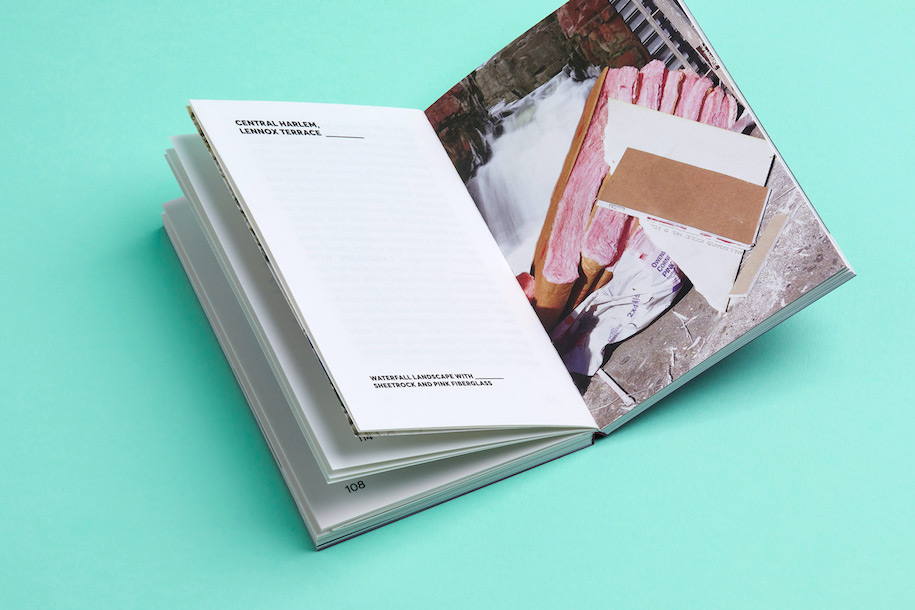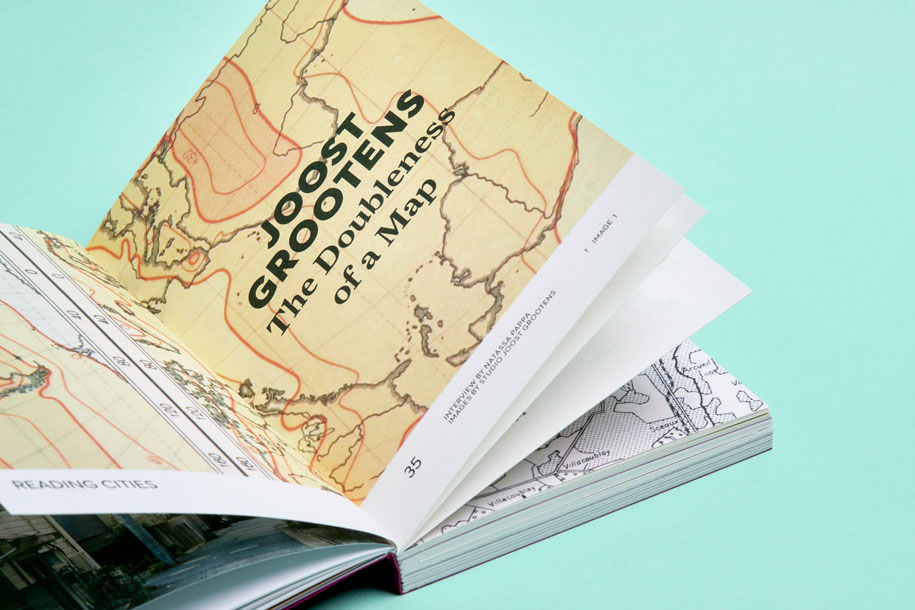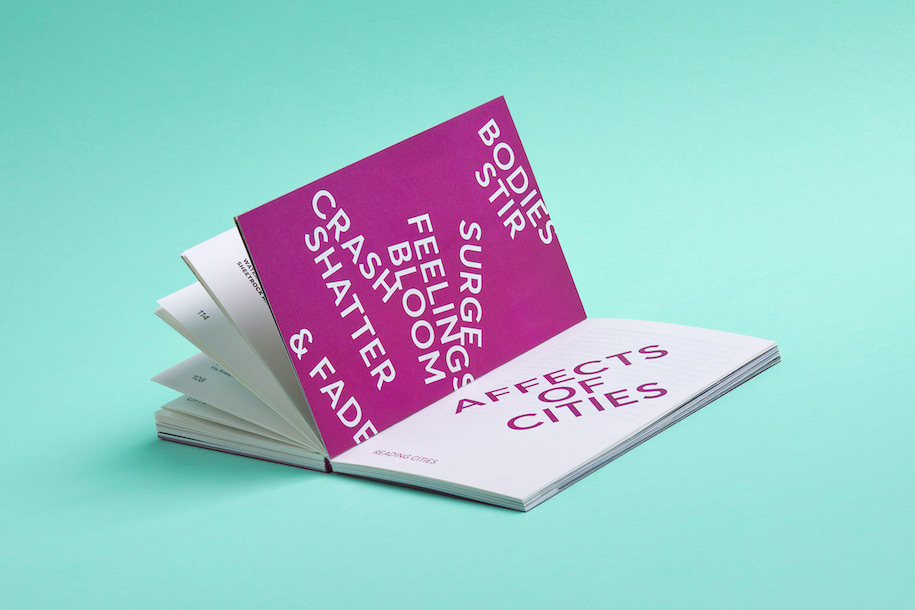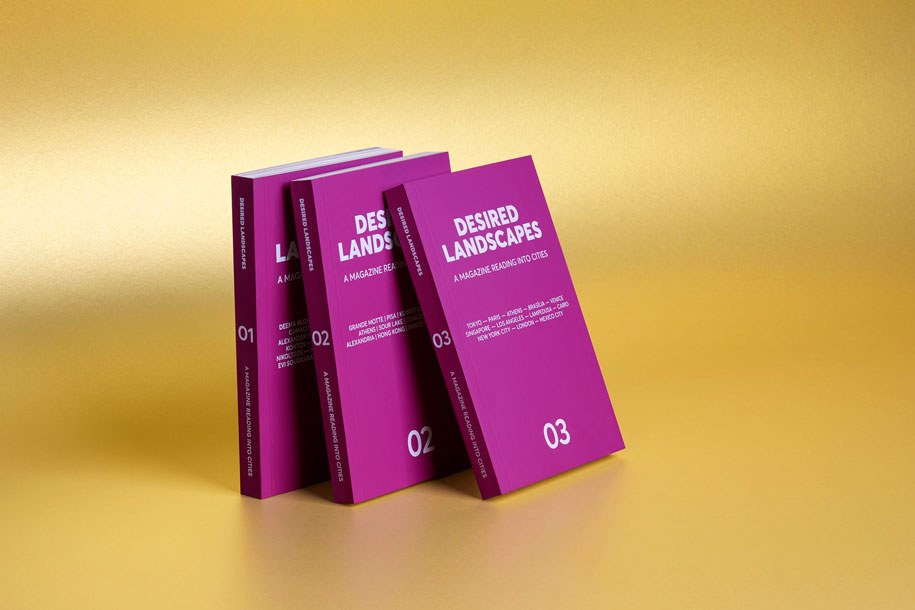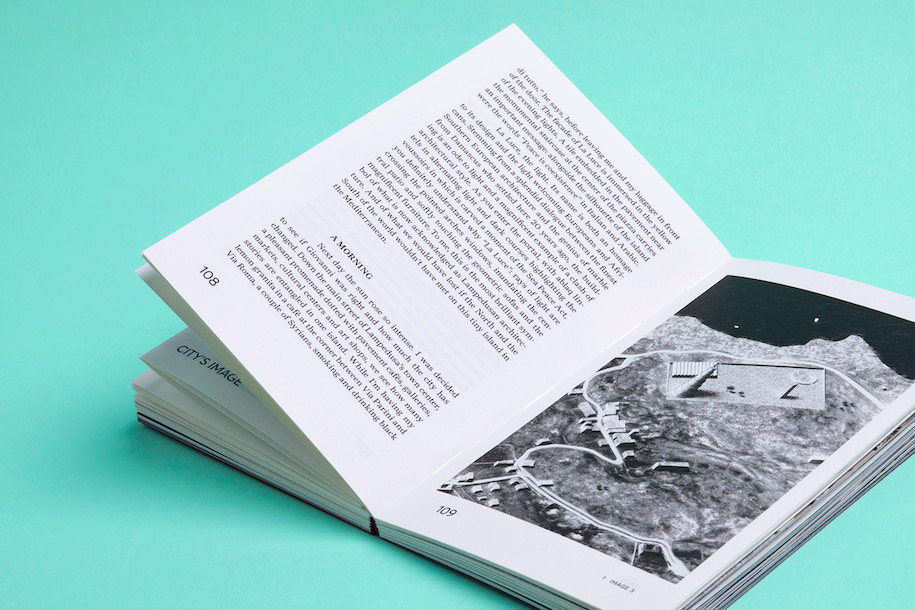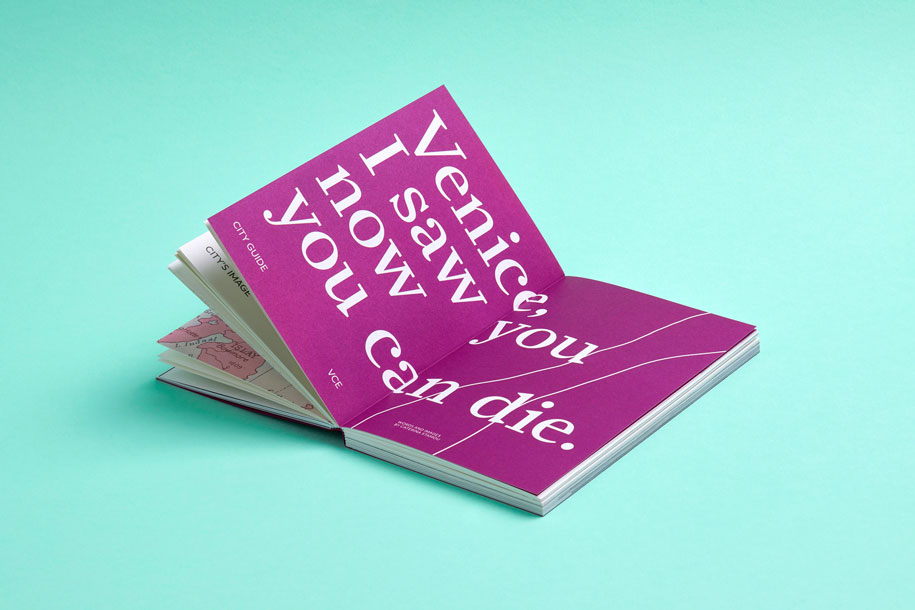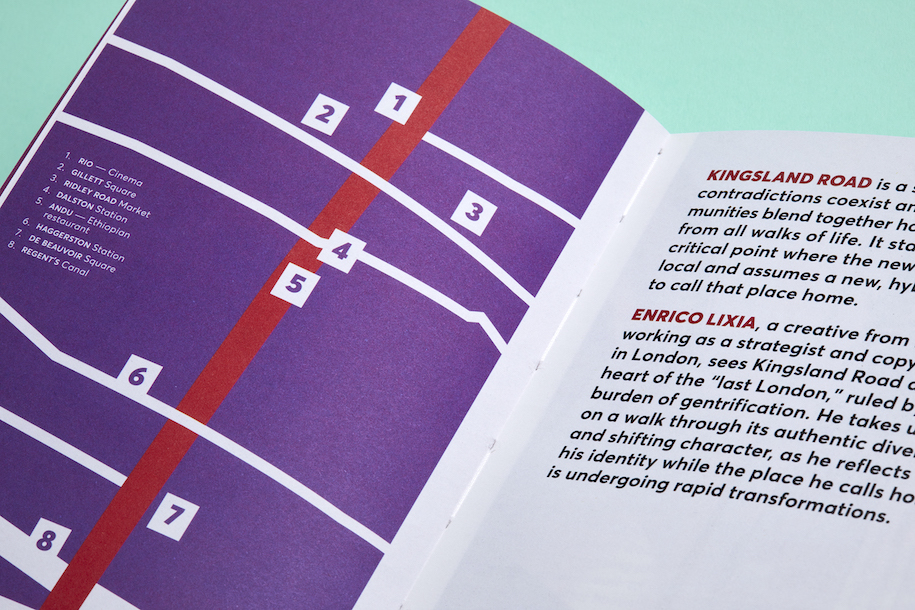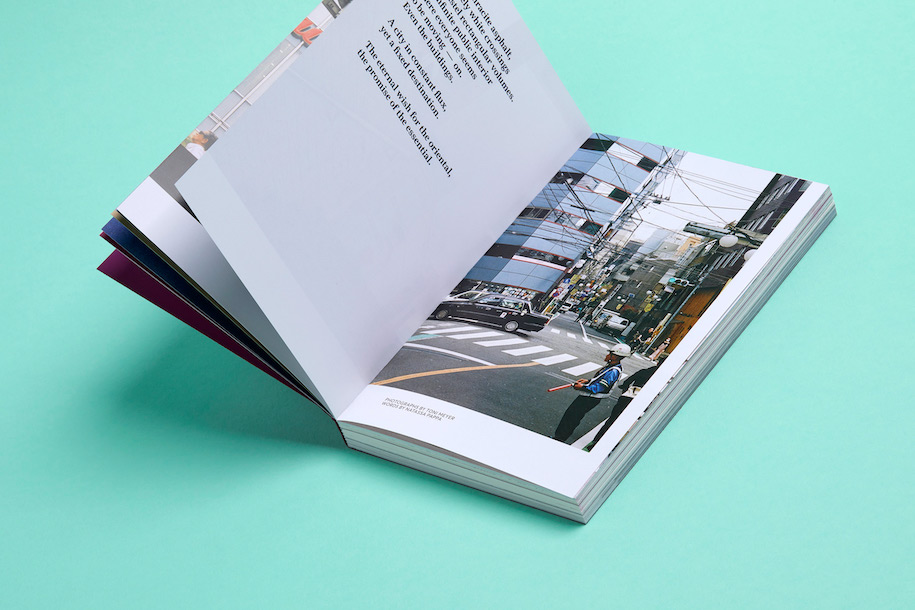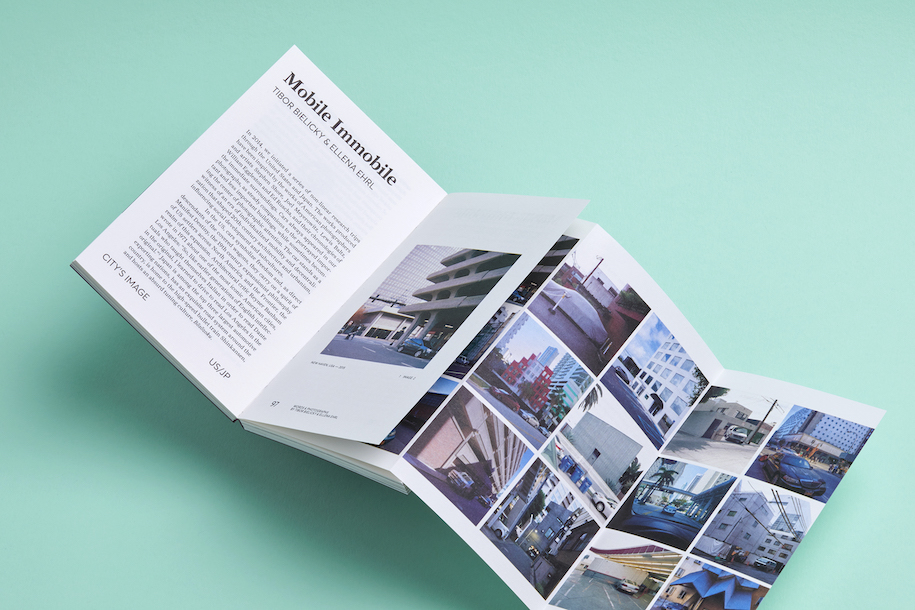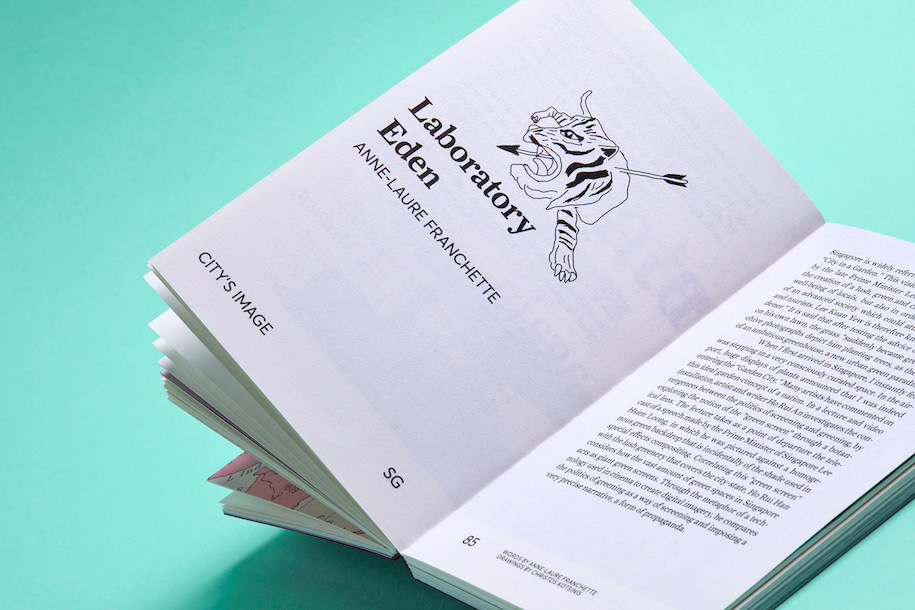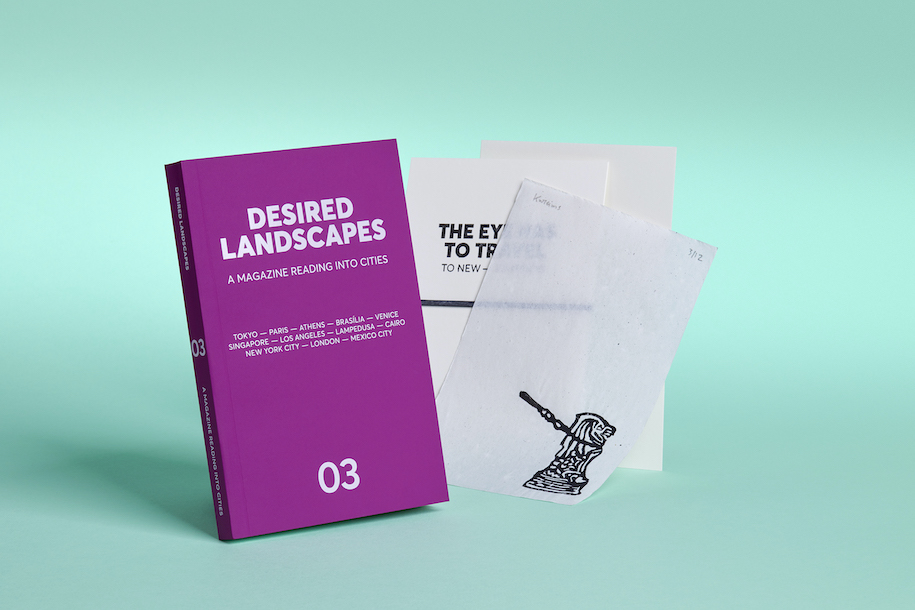Η Νατάσσα Παππά είναι γραφίστρια και δημιουργός του Desired Landscapes, ενός διαφορετικού οδηγού στις σύχρονες πόλεις. Διδάσκει graphic design, ενώ έχει συνεργαστεί μεταξύ άλλων με το Δήμο Αθηναίων, το Ιδρυμα Ωνάσση, το Μουσείο Κυκλαδικής Τέχνης, την Coco-mat, και το art-guide und. Athens. Απο το 2013 μέσω του [Street] (Design) [Words], ασχολείται με τον τομέα της αυτοέκδοσης με βασικό άξονα τη σχέση του ατόμου με το σύχρονο αστικό ιστό. Η δουλεία της είναι βραβευμένη και δημοσιευμένη στην Ελλάδα και το εξωτερικό. Μιλήσαμε μαζί της με αφορμή την κυκλοφορία του τρίτου τεύχους του Desired Landscapes.
Φωτογραφίες Γιώργος Βιτσαρόπουλος / Συνέντευξη Μαριάννα Τσαπέπα
Ενώ το βασικό σου αντικείμενο θα έλεγε κανείς ότι είναι η γραφιστική, το έργο σου έχει άμεση σχέση με το χώρο της πόλης, τη χαρτογράφηση και την αρχιτεκτονική. Πως και πότε ξεκίνησε αυτή η σχέση;
Ακριβώς. Επέλεξα να προσεγγίζω μια θεματική από διαφορετικές οπτικές αντί να προσεγγίζω ποικίλες θεματικές μόνο μέσα από την εξειδίκευση της γραφιστικής. Μου φάνηκε λιγότερο βαρετό. Αυτό ξεκίνησε το 2010, όπου στις μεταπτυχιακές μου σπουδές στην Ολλανδια ήρθα σε επαφή με μεθοδολογίες από άλλα πεδία όπως η αρχιτεκτονική. Στην πραγματικότητα όμως η γραφιστική (η εικόνα) είναι πάντα η αφετηρία και το φίλτρο μου.
Ολοκληρώνοντας τις σπουδές σου στο εξωτερικό, τι ήταν αυτό που σε “τράβηξε” πίσω στην Αθήνα;
Το 2013 ένιωθα ότι είχε ουσιαστικότερο νόημα να εφαρμόσω τις νέες μου γνώσεις περι placemaking στην Αθήνα, όπου το κέντρο παρέμενε σε εγκατάλειψη. Στην Ολλανδία τότε παρατηρούσα το ίδιο λάθος που θεωρώ συμβαίνει και στην Αθήνα: θέλει ο βορράς να γίνει νότος, και αντίστροφα. Δε γίνεται να σχεδιαστεί ένα Ρόττερνταμ με έντονο το στοιχείο της “πλατείας” όπως γίνεται στις μεσογειακές πόλεις, όπως δε γίνεται και μια πόλη που αγγίζει τους 40°C να πεζοδρομηθεί όπως η Σκανδιναβία. Από την πλευρά της γραφιστικής, παρατηρώ ότι υπερφορτώνουμε την πολή με γραφικά θεωρώντας πως αυτό θα βελτιώσει τη ροή της (βλ. Εμπορικό Τρίγωνο, Μεγάλος Περίπατος), ενώ στην ουσία αυτό που έχει ανάγκη η Αθήνα είναι η αφαίρεση εικόνων (βλ. αφαίρεση διαφημιστικών πινακίδων), για να αναδείξει αυτό που ήδη έχει, αλλά έχει καλυφθεί. Μέσα από μια τέτοια διαδικασία αφαίρεσης προέκυψε και ο οδηγός Εντός Στοάς.
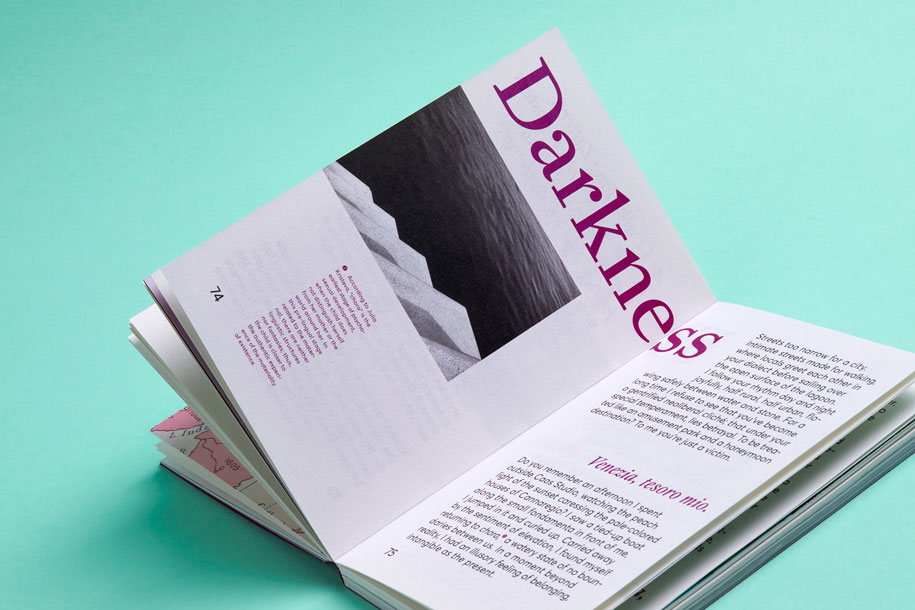
Η αγάπη σου για το αθηναϊκό κέντρο είναι εμφανής, μέσα από τη χαρτογράφηση των στοών “Into Stoas” που έχεις δημοσιεύσει, αλλά και τα Athens Walkthrough που πραγματοποιείς. Μπορείς να μας συστήσεις συνοπτικά τα δύο project και να μας εξηγήσεις αν συνδέονται;
Το Εντός Στοάς είναι ένας printed οδηγός πόλης, μια χαρτογράφηση των διαμπερών στοών του Εμπορικού Τριγώνου. Προέκυψε από την περιέργια καταγραφής και ανάλυσης των επιγραφών εξόδων των στοών, λόγω της ιδιαίτερης τυπογραφίας και τοποθέτησής τους. Το Athens Walkthrough ειναι μια περιήγηση βασισμένη σε αυτόν τον οδηγό, όπου μεταφέρω την προφορική ιστορία που έχω συλλέξει κατά τη διάρκεια της έρευνάς, καθώς περιηγούμαστε στο παλιό εμπορικό κομμάτι της πόλης που επιβιώνει ακόμα. Οι συμμετέχοντες ανακαλύπτουν σημεία της πόλης που προηγούμενως πιθανόν να μη χρησιμοποιούσαν τόσο, αλλά και τη σχέση της γραφιστικής με την εμπειρία της πόλης.
Πόσο καλά μπορεί να γνωρίζει τελικά κάποιος το κέντρο της Αθήνας; Κρύβει ακόμα μυστικά για εσένα;
Η Αθήνα είναι ατελείωτη (και γι’αυτό και επέστρεψα) και τελευταία αλλάζει δραστικά. Τι πιο συναρπαστικός συνδυασμος;! Μια βόλτα από την Ακρόπολη έως την Ομόνοια μέσω της Αιόλου, το επιβεβαιώνει.
Ιδιαίτερη αγάπη έχει λάβει απο το κοινό το Desired Landscapes, του οποίου είσαι δημιουργός. Μπορείς να μας εξηγήσεις πως δομείται η έκδοση και το περιεχόμενο κάθε τεύχους; Πρόκειται για ένα νέου τύπου “οδηγό” στις σύχρονες πόλεις;
Το Desired Landscapes απλά αναπτύσει την ερευνητική προσέγγισή μου σε νέες πόλεις. Πάλι μέσα από το πρίσμα της γραφιστικής και γενικότερα του visual culture, επισκεπτόμαστε πόλεις ως τουρίστες ή αναζητούμε τους ανθρώπους που θα μας “ξεναγήσουν” σε αυτές και την ιστορία τους. Αυτό καμιά φορά αγγίζει και τα όρια του φαντασιακού. Για παράδειγμα, στο τρίτο τεύχος ο Vincenzo Angileri μας πάει στην Λαμπεντούζα του 2050 όπου συναντά μνημεία της μαύρης εποχής του 2020 όπου το προσφυγικό δεν είχε ακόμα λυθεί.
Μίλησέ μας για το τρίτο τεύχος που μόλις κυκλοφόρησε. Πώς επιλέχθηκαν τα δημοσιευμένα κείμενα, που εστιάζουν;
Τα κείμενα επιλέγονται βάση των θεματικών τους και της ποιότητας γραφής, αλλά η τελική απόφαση επηρεάζεται από το σύνολο των πόλεων, ώστε να υπάρχουν οι απαιτούμενες αντιθέσεις. Το τρίτο τεύχος προέκυψε αρκετά εξωτικό χωρίς να το επιζητήσω, μιας και ήταν η πρώτη φορά που είπα να δοκιμάσω τη διαδικασία του open call για κάποιες επιλεγμένες στήλες. Μεταξύ άλλων περιλαμβάνει Βενετία, Λονδίνο, Τόκυο, Σιγκαπούρη και Μεξικό. Aρκετά κείμενα αγγίζουν το ερώτημα της ταυτότητας και της ιστορίας των πόλεων, καθώς αυτές εξελίσσονται.
Πως θα περιέγραφες τη σκηνή των αυτοεκδόσεων στην Ελλάδα σήμερα;
Παρατηρώ μια ποικιλία και από πλευράς περιεχομένου, αλλά και ύφους, και αυτό μου αρέσει πολύ.
Παράλληλα με τα προσωπικά σου project, διδάσκεις graphic design. Πως βιώνεις αυτή την αλληλεπίδραση; Αλλάζει τη σχέση με το αντικείμενό σου η νέα οπτική που βλέπεις μέσα απο τα μάτια των φοιτητών;
Και αυτό είναι ένα κομμάτι της ίδιας προσέγγισης, μιας και στο Εντός Στοάς και στο Desired Landscapes ερευνώ την ιστορία της γραφιστικής, ειδικά αυτά που δεν έχουν συμπεριληφθεί στα κλασικά βιβλια, όπως η Iστορία Γραφιστικής του Meggs. Για παράδειγμα, στο επόμενο τεύχος αναλύουμε λογότυπα που θα βρεις σε δημόσιους χώρους στο Κουβέιτ. Στη σχολη διδάσκω Ιστορία Γραφιστικής, Σύγχρονα Θέματα Γραφιστικής, αλλά και πρακτικά μαθήματα όπως Τυπογραφία. Στα συγκεκριμένα μαθήματα, είναι ό,τι καλύτερο να έχεις τη νέα γενιά γραφιστών να προσεγγίζουν τη θεματική των εκδόσεων και της πόλης, κάτι αρκετά μακρυνό για τη “γενιά της οθόνης”. Μέσα από συζητήσεις και πειραματισμούς ανακαλύπτουμε μαζί πιθανές νέες εφαρμογές της γραφιστικής.
Ποια είναι η γνώμη σου για τη σκηνή του graphic design στην Ελλάδα; Είναι η ελληνική “γραφή” αναγνωρίσιμη;
Το θέμα της ελληνικής (και οποιασδήποτε) γραφής είναι πολυδιάστατο και αρκετοί από εμάς το έχουν αναζητήσει μέσα από ερευνητικά έργα. Δε θα έλεγα ότι είναι αναγνωρίσιμη σήμερα, αλλά αυτό συνήθως έρχεται και με το πέρασμα του χρόνου και με το πώς αντιλαμβανόμαστε την ελληνικότητα σε κάθε περίοδο. Περισσότερο αναγνωρίζω σχεδιαστικές τάσεις, που φυσικά ακολουθούν τις παγκόσμιες.
Ποια design έντυπα απο το εξωτερικό ή την Ελλάδα παρακολουθείς;
Αυτό που σταθερά με ευχαριστεί να διαβάζω από το ξεκίνημά του είναι το, πλέον αγαπημένο όλων, Apartamento. Πέρα από αυτό εναλλάσω τους τίτλους, παρακολουθώντας την ανεξάρτητη σκηνή παγκοσμιώς. Επίσης αγαπημένα, και κάπως πιο mainstream, είναι το Gourmand και το Tank.
Ποια είναι τα σχέδια σου για το μέλλον; Τι project να περιμένουμε;
Ο Covid-19 έχει βάλει κάπως ένα φρένο στη φαντασία μου, ειδικά στο κομμάτι των custom ξεναγήσεων σε πόλεις στο εξωτερικό, όπως το Desired Bloomsbury που έγινε πέρσι στο Λονδίνο. Αυτή την περίοδο ετοιμάζω το επόμενο τεύχος του Desired Landscapes, συλλέγω υλικό για τα επόμενα newsletters “Reading Cities Archives”, σχεδιάζω ένα αρχιτεκτονικό βιβλίο, αλλά και μια πρόταση για ένα νέο θεωρητικό μάθημα. Ταυτόχρονα ήταν μια καλή ευκαιρία για απολογισμό, κι έτσι ανανεώνουμε το website του Desired Landscapes που πλέον θα συγκεντρώνει όλα τα προϊόντα μας, ακόμα και τις limited σειρές, όπως τα φανταστικά linocuts που σχεδίασε ο Χρήστος Κοτσίνης ειδικά για το launch του τρίτου τεύχους.
Natassa Pappa is a graphic designer and creator of Desired Landscapes, a different guide to modern cities. She teaches graphic design, and has collaborated with the Municipality of Athens, the Onassis Foundation, the Museum of Cycladic Art, Coco-mat, and the art-guide und. Athens. Since 2013, through [Street] (Design) [Words], she has been active in the field of self-publishing, focusing on the relationship of the individual with the contemporary urban fabric. Her work has been awarded and published in Greece and abroad. We spoke with her on the occasion of the release of the third issue of Desired Landscapes.
Photography by Yiorgos Vitsaropoulos / Interview by Marianna Tsapepa
While your main occupation would be graphic design, your work is directly related to the city, mapping and architecture. How and when did this relationship start?
Exactly. I chose to approach a subject from different perspectives instead of approaching a variety of subjects only through the specialization of graphic design. It seemed less boring to me. This started in 2010, when in my postgraduate studies in the Netherlands I came in contact with methodologies from other fields such as architecture. In reality, however, graphic design (the image) is always my starting point and filter.
After completing your studies abroad, what attracted you about going back to Athens?
In 2013 I felt that it made more sense to apply my new knowledge about placemaking in Athens, where the city center remained abandoned. In the Netherlands I had observed the same mistake that I think happens in Athens: the north wants to be more like the south, and vice versa. It is not possible to design Rotterdam based on the element of “the square”, as it is done in Mediterranean cities, just as it is not possible to design a city that reaches 40°C to be pedestrianized like in Scandinavia. From the graphic design point of view, I notice that we overload the city with graphics considering that this will improve its flow (see the the Commercial “Triangle”, and the “Great Walk” in the center of Athens), while in essence what Athens needs is the removal of images (see removal of billboards ), to highlight what it already has but has been covered. Through such a removal process, the guidebook “Into Stoas” emerged as well.
Your love for the Athenian city center is obvious, through the mapping of the “Into Stoas” guidebook that you have published, as well as the “Athens Walkthrough” that you organize. Can you briefly introduce the two projects and explain if they are related?
“Into Stoas” is a printed city guide, a mapping of the bright galleries of the Commercial “Triangle” that is defined by the three main avenues in the center of Athens: Panepistimiou, Athinas and Mitropoleos. It arose from the curiosity of recording and analyzing the signs of the exits of the arcades (in Greek: stoas), due to the special typography and placement of the signs. “Athens Walkthrough” is a tour based on this guide, where I convey the oral history I have collected during the research as we tour the old commercial part of the city that still survives. Participants discover places in the city that they may not have seen before, as well as the relationship between graphic design and the city experience.
How well can one know the center of Athens? Does it still hold secrets for you?
Athens is endless (and that is why I returned) and lately it has been changing drastically. Is there a more exciting combination?! A walk from the Acropolis to Omonia through Aiolou street can always confirms this for me.
Desired Landscapes, of which you are the creator, has received a lot of appreciation from the public. Can you explain to us how the edition and the content of each issue are structured? Is it a new type of “guide” in modern cities?
Desired Landscapes developed my research approach to new cities. Again through the prism of graphic design and visual culture in general, we visit cities as tourists or look for people who will “guide” us to them and their history. This sometimes reaches the limits of the imaginary. For example, in the third issue, Vincenzo Angileri takes us to Lampedusa in 2050 where he meets monuments of the black era of 2020 where the refugee crisis had not yet been resolved.
Tell us about the third issue that has just been released. How were the published texts focused on selected?
The texts are selected based on their themes and the quality of writing, but the final decision is made so that the all the cities presented have contrasts among them to form an interesting outcome. The third issue turned out to be quite exotic not on purpose, since it was the first time I tried the open call process for some selected columns. These include Venice, London, Tokyo, Singapore and Mexico. Several texts touch on the question of identity and history of cities as they evolve.
How would you describe the self-publishing scene in Greece today?
I notice a variety in terms of content, but also style, and I really like that.
Along with your personal projects, you teach graphic design. How do you experience this interaction? Does the new perspective you see through the eyes of the students change the relationship with your subject?
This is part of the same approach, as “Into Stoas” and Desired Landscapes. I research the history of graphic design, especially those not included in classic books such as Meggs’ Graphic Design History. For example, in the next issue we will analyze logos that you will find in public places in Kuwait. In the school I teach History of Graphic Design, Contemporary Graphic Design, but also practical courses such as Typography. In these courses, it is best to have the new generation of graphic designers approach the issues of publishing and the city, something far away from the experiences of the “screen generation”. Through discussions and experimentation we discover together possible new applications of graphic design.
What is your opinion about the graphic design scene in Greece? Is Greek “writing” recognizable?
The subject of Greek (or any) writing is multidimensional and many graphic designers us have investigated it through research projects. I would not say that it is recognizable today, but this usually comes with the passage of time and with how we perceive Greekness in each period. I mostly recognize design trends, which of course are global.
Which design magazines from Greece or other countries do you read?
What I have consistently enjoyed reading since its inception is Apartamento, everyone’s favorite. Beyond that I alternate titles, keeping an eye on the independent scene worldwide. Also favorites, and somewhat more mainstream, are Gourmand and Tank.
What are your plans for the future? What projects should we expect?
Covid-19 has put a bit of a “brake” on my imagination, especially in the area of custom city tours abroad, such as Desired Bloomsbury which took place last year in London. I am currently preparing the next issue of Desired Landscapes, collecting material for the next newsletters “Reading Cities Archives”, designing an architectural book, but also a proposal for a new theoretical course. At the same time it was a good opportunity to take stock, and so we renew the website of Desired Landscapes that will now gather all our products, even the limited series, such as the fantastic linocuts designed by Christos Kotsinis especially for the launch of the third issue.
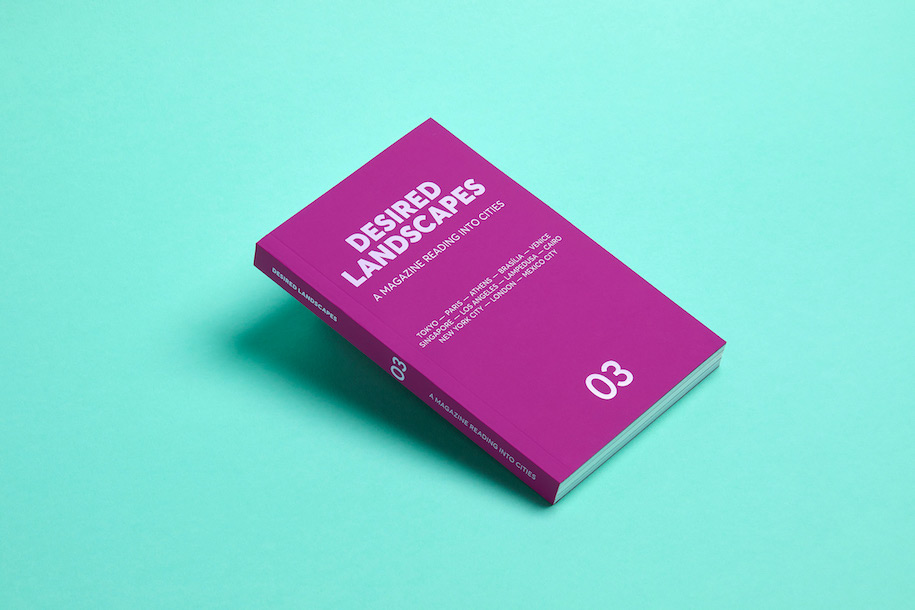
READ ALSO: Archisearch Talks: Maria Deda - Podcast Recap
